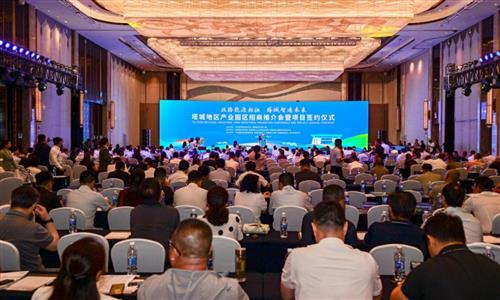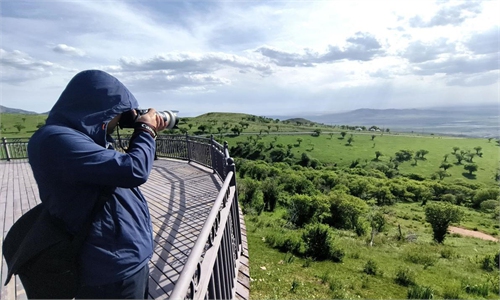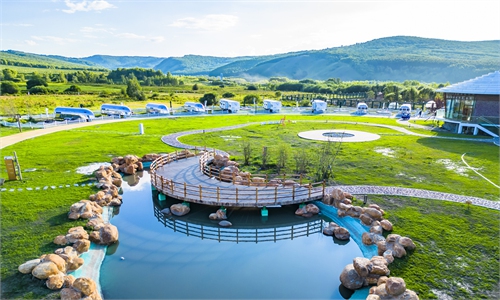SOURCE / PRESS RELEASE
A Remarkable Transformation from Ancient Post Town to Thriving Tourist Destination — The Evolution and Upgrade of Tourism Development in Wusu, Tacheng Prefecture, Xinjiang
From improvements in transportation networks to upgrades in hotels and dining services, and from the quality enhancement and expansion of scenic areas to explosive surges in tourist numbers, Wusu city in Xinjiang's Tacheng Prefecture has, in recent years, transformed from a small post station along the ancient Silk Road into a key destination on Xinjiang's tourism map.
According to official data, Wusu city in Xinjiang's Tacheng Prefecture greeted 6.212 million tourist visits in 2024, representing a year-on-year increase of 24.21 percent. From January to May 2025, the city welcomed 2.7239 million visitor trips, up 40.83 percent compared to the same period last year. Behind these impressive figures lies Wusu's strategic planning and continued investment in the tourism sector.
Enhancing Infrastructure to Improve the "Last Kilometer" of Tourism Services
"We have built 15 public toilets and 21 parking lots with total capacity for 2,300 vehicles along a 91-kilometer section of the Wusu segment of the Duku Highway in Xinjiang," said Wu Qianlin, Director of the Project Office at the Wusu Municipal Bureau of Culture, Sports, Radio, Television and Tourism (hereinafter referred to as the "Wusu Municipal Bureau of Culture and Tourism"), on June 19.
These service facilities along the Duku Highway are just one example of Wusu's ongoing efforts to strengthen tourism infrastructure.
Located at a key juncture along the ancient Silk Road, Wusu in Xinjiang serves as a vital transportation hub linking Yili, Tacheng, and other regions. Since the early Qing Dynasty, a bustling post station was established north of Wusu city, providing a resting place for officials and merchants traveling east and west.
In the new era, to fully leverage the geographical advantages of Provincial Highway 101 and the Duku Highway (G217), Wusu city in Xinjiang has invested 120 million yuan ($16.7 million) in constructing "Wusu Post Station" at the intersection of these two major tourist routes. Offering "comprehensive services including dining, accommodation, transportation, sightseeing, shopping, and entertainment," the project aims to establish an "eastern gateway" and "reception hall" for Wusu tourism, further enhancing the visibility of the city's tourism brand.
In recent years, Wusu in the Tacheng Prefecture of Xinjiang has made a series of "bold moves" in developing its tourism infrastructure.
At the construction site of the S101 extension project, work is progressing in full swing. Upon completion, the project will break through the natural barrier of the Kuitun River, redirecting traffic from the Duku Highway (G217) into Wusu. This will help establish a vibrant tourism and consumption hub centered around the Daifuseng Scenic Area. The project is expected to drive the integrated development of "transportation + tourism," "transportation + industry," and "transportation + rural revitalization," injecting strong momentum into the rapid growth of Wusu's tourism sector.
According to available information, Wusu city in Xinjiang has continuously increased investment in infrastructure during the development of its scenic areas, with a strong focus on improving the quality of tourism services. A total of 54 cultural and tourism projects have been newly launched, continued, or reserved, with a combined investment of approximately 3.431 billion yuan.
Hotel and Dining Facilities: Shifting from "Basic Accommodation" to "Quality Experience"
"Our current occupancy rate is between 80 and 90 percent," said Huang Xingzhi, General Manager of Jinjiang Inn in Wusu city, on June 18.
Recently, a number of hotels in Wusu, including Jinjiang Inn and Mingsheng Grand Hotel, have been completed and put into operation.
As various star-rated hotels, budget hotels, and smart hotels spring up across the city, Gui Xiang, an official from the Wusu Municipal Bureau of Culture and Tourism, reflected on the progress made. During the first Wusu Beer Festival held in 2008, the city's limited accommodation capacity meant that two-thirds of invited guests had to be shuttled to hotels in Kuitun and Dushanzi. "At that time, the total number of beds in all hotels and guesthouses in Wusu was fewer than 1,000," Gui recalled.
Over the past two years, Wusu city in Xinjiang has actively promoted the development of mid-to-high-end cultural and tourism projects, including star-rated and budget hotels, in an effort to comprehensively enhance urban functions and quality, and to further boost the development of the tourism industry.
At present, Wusu has 115 hotels and guesthouses in normal operation, offering more than 6,000 beds. Among them, five are star-rated hotels, including one four-star hotel and four three-star hotels.
Scenic Area Development: Shifting from "Single-Site Sightseeing" to "All-for-One Tourism"
"Today, when you visit Wusu in Xinjiang, you can experience not only natural landscapes like alpine grasslands and desert poplar forests, but also a variety of parks, homestays, and cultural villages — there's something new to explore every day for at least three days," said Ms. Chen, a tourist from Guangdong, sharing her travel experience in Wusu.
In recent years, Wusu city has actively advanced the construction of tourism projects under the "all-for-one tourism" strategy. With a strong focus on developing distinctive tourism brands, the city is striving to build a new integrated tourism development model across its entire territory.
At the Daifuseng Scenic Area, the air is fresh and pleasant, attracting many tourists seeking a summer retreat. "I come here every holiday," said Liu Weijie, a visitor from Karamay. "The environment is excellent — it's like a natural oxygen bar."
As part of its "Attracting Visitors to Wusu" campaign, the city has also introduced a number of innovative initiatives.
In April this year, Wusu city in Xinjiang launched the "Spring in Tacheng - Ten Thousand Tourists Visit Wusu" campaign, inviting over 10,000 visitors from Urumqi, Changji, Shihezi, and other regions to explore the city.
Wusu has been actively tapping into the unique characteristics of its rural areas by implementing a "One Village, One Product" strategy to build a diverse matrix of rural cultural tourism brands. From the grassland culture of Baiyanggou town, to the intangible cultural heritage of Tabulehete township, and the farming traditions of Jiujianlou township, local tourism brands continue to gain popularity, attracting large numbers of visitors eager to experience rural life and enjoy local cuisine.
"In the future, Wusu will continue to improve its tourism infrastructure, enhance service quality, and enrich tourism offerings, with the goal of developing cultural tourism into a pillar industry," said Yu Jie, Party Secretary and Deputy Director of the Wusu Municipal Bureau of Culture and Tourism.
According to official data, Wusu city in Xinjiang's Tacheng Prefecture greeted 6.212 million tourist visits in 2024, representing a year-on-year increase of 24.21 percent. From January to May 2025, the city welcomed 2.7239 million visitor trips, up 40.83 percent compared to the same period last year. Behind these impressive figures lies Wusu's strategic planning and continued investment in the tourism sector.
Enhancing Infrastructure to Improve the "Last Kilometer" of Tourism Services
"We have built 15 public toilets and 21 parking lots with total capacity for 2,300 vehicles along a 91-kilometer section of the Wusu segment of the Duku Highway in Xinjiang," said Wu Qianlin, Director of the Project Office at the Wusu Municipal Bureau of Culture, Sports, Radio, Television and Tourism (hereinafter referred to as the "Wusu Municipal Bureau of Culture and Tourism"), on June 19.
These service facilities along the Duku Highway are just one example of Wusu's ongoing efforts to strengthen tourism infrastructure.
Located at a key juncture along the ancient Silk Road, Wusu in Xinjiang serves as a vital transportation hub linking Yili, Tacheng, and other regions. Since the early Qing Dynasty, a bustling post station was established north of Wusu city, providing a resting place for officials and merchants traveling east and west.
In the new era, to fully leverage the geographical advantages of Provincial Highway 101 and the Duku Highway (G217), Wusu city in Xinjiang has invested 120 million yuan ($16.7 million) in constructing "Wusu Post Station" at the intersection of these two major tourist routes. Offering "comprehensive services including dining, accommodation, transportation, sightseeing, shopping, and entertainment," the project aims to establish an "eastern gateway" and "reception hall" for Wusu tourism, further enhancing the visibility of the city's tourism brand.
In recent years, Wusu in the Tacheng Prefecture of Xinjiang has made a series of "bold moves" in developing its tourism infrastructure.
At the construction site of the S101 extension project, work is progressing in full swing. Upon completion, the project will break through the natural barrier of the Kuitun River, redirecting traffic from the Duku Highway (G217) into Wusu. This will help establish a vibrant tourism and consumption hub centered around the Daifuseng Scenic Area. The project is expected to drive the integrated development of "transportation + tourism," "transportation + industry," and "transportation + rural revitalization," injecting strong momentum into the rapid growth of Wusu's tourism sector.
According to available information, Wusu city in Xinjiang has continuously increased investment in infrastructure during the development of its scenic areas, with a strong focus on improving the quality of tourism services. A total of 54 cultural and tourism projects have been newly launched, continued, or reserved, with a combined investment of approximately 3.431 billion yuan.
Hotel and Dining Facilities: Shifting from "Basic Accommodation" to "Quality Experience"
"Our current occupancy rate is between 80 and 90 percent," said Huang Xingzhi, General Manager of Jinjiang Inn in Wusu city, on June 18.
Recently, a number of hotels in Wusu, including Jinjiang Inn and Mingsheng Grand Hotel, have been completed and put into operation.
As various star-rated hotels, budget hotels, and smart hotels spring up across the city, Gui Xiang, an official from the Wusu Municipal Bureau of Culture and Tourism, reflected on the progress made. During the first Wusu Beer Festival held in 2008, the city's limited accommodation capacity meant that two-thirds of invited guests had to be shuttled to hotels in Kuitun and Dushanzi. "At that time, the total number of beds in all hotels and guesthouses in Wusu was fewer than 1,000," Gui recalled.
Over the past two years, Wusu city in Xinjiang has actively promoted the development of mid-to-high-end cultural and tourism projects, including star-rated and budget hotels, in an effort to comprehensively enhance urban functions and quality, and to further boost the development of the tourism industry.
At present, Wusu has 115 hotels and guesthouses in normal operation, offering more than 6,000 beds. Among them, five are star-rated hotels, including one four-star hotel and four three-star hotels.
Scenic Area Development: Shifting from "Single-Site Sightseeing" to "All-for-One Tourism"
"Today, when you visit Wusu in Xinjiang, you can experience not only natural landscapes like alpine grasslands and desert poplar forests, but also a variety of parks, homestays, and cultural villages — there's something new to explore every day for at least three days," said Ms. Chen, a tourist from Guangdong, sharing her travel experience in Wusu.
In recent years, Wusu city has actively advanced the construction of tourism projects under the "all-for-one tourism" strategy. With a strong focus on developing distinctive tourism brands, the city is striving to build a new integrated tourism development model across its entire territory.
At the Daifuseng Scenic Area, the air is fresh and pleasant, attracting many tourists seeking a summer retreat. "I come here every holiday," said Liu Weijie, a visitor from Karamay. "The environment is excellent — it's like a natural oxygen bar."
As part of its "Attracting Visitors to Wusu" campaign, the city has also introduced a number of innovative initiatives.
In April this year, Wusu city in Xinjiang launched the "Spring in Tacheng - Ten Thousand Tourists Visit Wusu" campaign, inviting over 10,000 visitors from Urumqi, Changji, Shihezi, and other regions to explore the city.
Wusu has been actively tapping into the unique characteristics of its rural areas by implementing a "One Village, One Product" strategy to build a diverse matrix of rural cultural tourism brands. From the grassland culture of Baiyanggou town, to the intangible cultural heritage of Tabulehete township, and the farming traditions of Jiujianlou township, local tourism brands continue to gain popularity, attracting large numbers of visitors eager to experience rural life and enjoy local cuisine.
"In the future, Wusu will continue to improve its tourism infrastructure, enhance service quality, and enrich tourism offerings, with the goal of developing cultural tourism into a pillar industry," said Yu Jie, Party Secretary and Deputy Director of the Wusu Municipal Bureau of Culture and Tourism.



